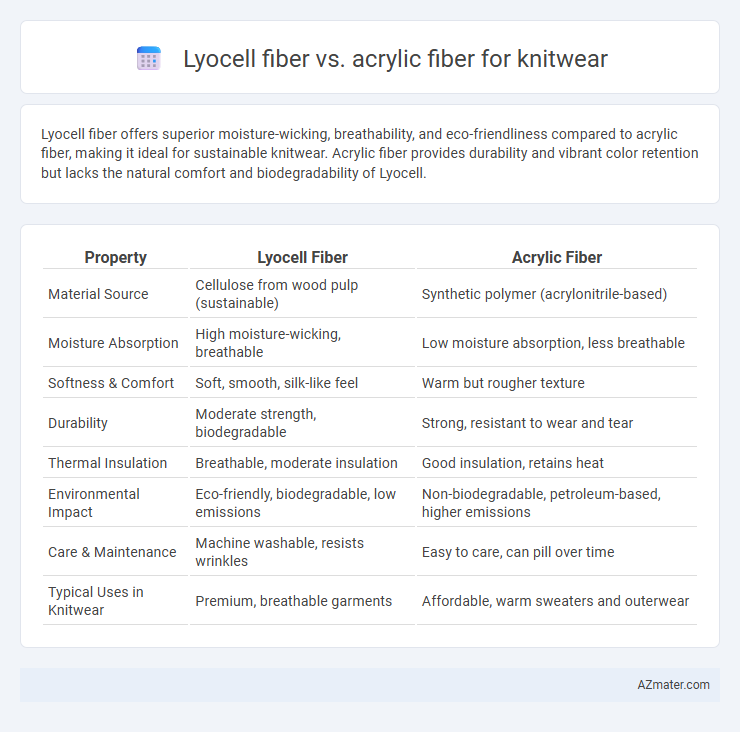Lyocell fiber offers superior moisture-wicking, breathability, and eco-friendliness compared to acrylic fiber, making it ideal for sustainable knitwear. Acrylic fiber provides durability and vibrant color retention but lacks the natural comfort and biodegradability of Lyocell.
Table of Comparison
| Property | Lyocell Fiber | Acrylic Fiber |
|---|---|---|
| Material Source | Cellulose from wood pulp (sustainable) | Synthetic polymer (acrylonitrile-based) |
| Moisture Absorption | High moisture-wicking, breathable | Low moisture absorption, less breathable |
| Softness & Comfort | Soft, smooth, silk-like feel | Warm but rougher texture |
| Durability | Moderate strength, biodegradable | Strong, resistant to wear and tear |
| Thermal Insulation | Breathable, moderate insulation | Good insulation, retains heat |
| Environmental Impact | Eco-friendly, biodegradable, low emissions | Non-biodegradable, petroleum-based, higher emissions |
| Care & Maintenance | Machine washable, resists wrinkles | Easy to care, can pill over time |
| Typical Uses in Knitwear | Premium, breathable garments | Affordable, warm sweaters and outerwear |
Introduction to Lyocell and Acrylic Fibers
Lyocell fiber, derived from sustainably sourced wood pulp, offers superior moisture absorption, breathability, and softness, making it ideal for eco-friendly knitwear. Acrylic fiber, a synthetic polymer, is favored for its durability, vibrant color retention, and resistance to moths and mildew in knit garments. Knitwear manufacturers often balance Lyocell's natural comfort with Acrylic's robust performance to achieve versatile fabric blends.
Fiber Origin and Manufacturing Processes
Lyocell fiber originates from sustainably sourced wood pulp, primarily eucalyptus, utilizing a closed-loop solvent spinning process that minimizes environmental impact and ensures biodegradability. Acrylic fiber, derived from synthetic polymer acrylonitrile through a complex chemical polymerization and spinning process, is petroleum-based and less eco-friendly. The natural origin and environmentally conscious manufacturing of Lyocell contrast sharply with the petrochemical-intensive production of Acrylic, influencing their sustainability profiles in knitwear applications.
Environmental Impact and Sustainability
Lyocell fiber is derived from sustainably sourced wood pulp using a closed-loop process that recycles water and solvents, resulting in minimal environmental impact and biodegradability, making it a highly eco-friendly choice for knitwear. Acrylic fiber, produced from non-renewable petroleum-based chemicals, involves energy-intensive manufacturing and generates microplastic pollution during washing, raising significant sustainability concerns. Choosing lyocell over acrylic supports reduced carbon footprint, lower water usage, and enhanced end-of-life decomposition for more sustainable knitwear production.
Comfort and Skin-Friendliness
Lyocell fiber offers superior comfort compared to acrylic fiber due to its excellent moisture absorption and breathability, making it ideal for knitwear worn close to the skin. Its naturally smooth surface reduces irritation and promotes skin-friendliness, especially beneficial for sensitive skin types. Acrylic fiber, while durable and lightweight, tends to trap heat and can cause static, often resulting in less comfort and potential skin irritation during prolonged wear.
Durability and Longevity
Lyocell fiber exhibits superior durability and longevity in knitwear due to its strong cellulose-based structure, resisting wear and tear effectively while maintaining softness. Acrylic fiber, although lightweight and resistant to moisture, tends to pill and degrade faster through repeated washing and friction. Choosing lyocell for knitwear ensures enhanced fabric resilience and a longer lifespan compared to acrylic blends.
Moisture Management and Breathability
Lyocell fiber offers superior moisture management and breathability compared to acrylic fiber, as its sustainable cellulose structure efficiently wicks moisture away from the skin and promotes airflow. Acrylic fiber tends to trap heat and moisture due to its synthetic composition, which can lead to discomfort during extended wear in active or warm conditions. Knitwear made with Lyocell ensures enhanced comfort and dryness, making it an ideal choice for performance-oriented and eco-friendly apparel.
Thermal Properties in Knitwear
Lyocell fiber exhibits superior moisture-wicking and breathability compared to acrylic fiber, enhancing thermal regulation in knitwear by maintaining a cooler, drier microclimate. Acrylic fiber tends to retain heat due to its synthetic structure, making it less effective in temperature modulation but useful for insulation in colder conditions. Knitwear combining lyocell's thermal comfort with acrylic's warmth offers an optimized balance for versatile climate wear.
Dyeability and Color Retention
Lyocell fiber exhibits superior dyeability due to its cellulose-based structure, allowing for vibrant and uniform color absorption in knitwear. Acrylic fiber, being synthetic, offers good initial color vibrancy but tends to fade faster with washing and UV exposure, impacting long-term color retention. For knitwear requiring durable and rich coloration, Lyocell provides enhanced colorfastness and maintains shade brilliance over time compared to acrylic.
Cost Comparison for Knitwear Production
Lyocell fiber offers higher initial material costs compared to acrylic fiber but provides long-term value through superior durability and sustainability, reducing overall production expenses for knitwear. Acrylic fiber is more cost-effective upfront due to lower raw material prices and easier processing, making it suitable for budget-conscious knitwear manufacturers. However, lyocell's eco-friendly production and biodegradability can lower environmental compliance costs and appeal to premium market segments, potentially offsetting its higher initial investment.
Best Applications and Final Recommendations
Lyocell fiber excels in knitwear applications requiring softness, breathability, and moisture-wicking properties, making it ideal for performance and casual apparel. Acrylic fiber suits knitwear demanding durability, colorfastness, and warmth, commonly used in sweaters and outerwear. Choosing Lyocell benefits skin-sensitive and eco-conscious consumers, while Acrylic delivers robust, cost-effective warmth for heavy-duty fashion pieces.

Infographic: Lyocell fiber vs Acrylic fiber for Knitwear
 azmater.com
azmater.com